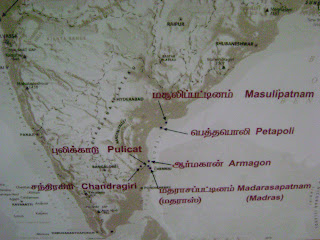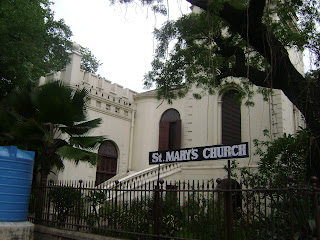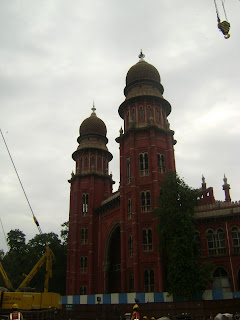Srirangapatnam in South India was the former capital of Mysore during the reign of Tippu Sultan, the ruler of the Mysore kingdom (much of the present day Karnataka).Amazed by reading the stories of courage and valour of Hyder Ali and Tippu Sultan ( the father-son duo who were the rulers of the Mysore kingdom) against the British rule in India, I decided to see for myself the various historic sites which speak the stories.
My mind had been craving for an adventure for quite sometime and one fine Saturday, everything fell in place when I set off catching the morning train from Bangalore to Mysore.
The overcrowded train , in which even the reservation compartment treated those with and without a ticket as equals, finally set off from Bangalore. Numerous small towns dotted our entire journey to Srirangapatnam.
However, the effect of the drought looming on this part of the country was outright visible. The fields of fertile Mandya no longer appeared lush green as it had been exactly 3 years ago when I passed through the same route. A sad state of monsoons in India this year. After about 2 hours 15 minutes , I reached Srirangapatnam.
Srirangapatna is a small town situated at distance of about 6 to 10 km from the present day town of Mysore. The present day Srirangapatnam is a small town frequented by locals and tourists for the very sacred and hugely popular Sriranganathaswamy temple, Nimishamba temple and other historic monuments.
My first stop in the town was the historic Sriranganathaswamy temple, a 1200 year old ancient temple, just a stone's throw from the station.
I had a very good darshan of Long Ranganatha, Sri Hanuman and the other gods - which I thought was a very good way to start the trip. Just a 2 min walk away was the Government Museum which sadly had no one except for the caretakers of the museum.
The building itself being an historic building captured my attention and so did the beautiful idols (excavated from the nearby towns such as Maddur,Mandya etc.) belonging to the era from 10th century onwards. The museum had very good photographs of various historic monuments and sites in and around Karnataka ,the famed Dussera Celebrations in Mysore etc. . Some of the interesting photos included the pond of Tippu's sister in Melukote, the various temples belonging to the Hoysala kingdom, the various Muslim monuments in Karnataka such as the Ibrahim Rauza and the Gol Gumbaz in Bijapur, Mahamood Gavan's Madrasa in Bidar and other interesting monuments.
Below is a pic of an idol of Surya excavated from Maddur belonging to the 10th century.
Just adjacent to the museum, is the ruins of the Lal Mahal, once a magnificent palace in which Tippu Sultan lived which was subsequently burnt by the British few years after the capture of Srirangapatna in 1799. Captured is some information given by the Archaelogy Society of India (ASI) on the same.
As I walked further down the beautiful town, I came across some interesting sights from the green countryside.. Observe the beautifully painted carts driven by the cattle...!
As you might have been aware, Tippu Sultan was an epitome of courage and valour and one of the very few Indian kings to have defeated the British. Tippu captured the British and kept them as prisoners in the dungeons , the most famous of them being the Colonel Bailley's dungeon. Shown below is the the place where the Colonel Bailley who was captured by forces of Tippu and Hyder Ali during the Second Anglo-Mysore War was housed. He ultimately died in the dungeon.
The very scene where Colonel Bailley is captured and carried on a palanquin as a prisoner of the war is depicted as an beautiful oil painting that houses the walls of the Dariya Daulat Mahal - the summer palace of Tippu Sultan at Srirangapatnam. The painting truly captures the awe of the observer and one is transported back in time to the era of Tippu Sultan .
As we walk further down on the road, we come across the Water Gate, a part of the fort. I met two women there who wanted to be photographed :) So here it is, the picture of the two women with the Water Gate in the background. The warm, caring and helpful people of Srirangapatna need special mention here. The locals go out of the way to help the tourists with the directions.
Tippu's body was found just 50 meters from the Water Gate.The place where Tippu's body was found is marked by the British. The British had very high regard for Tippu as a warrior, though he was eventually killed in their hands owing to the lack of support he received from the local rulers of other neightbouring princely states such as the Maratha Kingdom and Hyderabad.
Further down, from a distance, one can view the beautiful minarets of the Jumma Masjid mosque built by Tippu Sultan. Tippu also addressed the public from here.
As we proceed further, we see the beautiful architecture of the mosque, and I spent some time gazing at its architecture from outside..
I proceed further by walk to the bus station passing through further ruins of the fort.
Some of them even serving as cycle and scooter stands as the one below..
I proceed further down to the famous Dariya-Daulat Bagh (translated as the Garden of the Wealth of the Sea), the summer palace of Tippu Sultan . Its truly a treasure trove of paintings, jewels and other artifacts of Tippu Sultan.The exteriors of the palace are extremely beautiful with well maintained gardens and the grass gleaming in the mild rains. It is one of the best maintained monuments in India , with the efforts to conserve the palace taken right from the days of Britishers when Lord Dalhousie during his visit was spellbound with the beautiful paintings on the walls and ordered for the conservation of them. The Archaelogical Survey of India (ASI) continued the efforts on the conservation and preservation of the monuments and have done a great job at it. Shown below is a picture the palace exteriors.
Observe the beautiful lush green gardens surrounding the palace in the photo below.
The exteriors of the palace are covered by Bamboo sheets as a conservation measure to protect the beautiful oil paintings that give a glimpse into the glorious past of India.
A photo exhibition conducted by the Archaelogical Society of India (ASI) to mark its 150th Anniversary was going on at the time of my visit. The photo gallery showcased the amazing historic and culture heritage of Karnataka. It exhibited several photos of the monuments in Karnataka - Temples belonging to the Vijaynagar,Wodeyar era and Islamic monuments belonging to the Abdalis of Bijapur and Bidar and the Bahmanis of Gulbarga were exhibited.
The paintings on the walls of the palace were truly a class apart. Never before had I seen a historic painting depicting a scene as if it were happening live in front of my eyes. The Storming of Srirangapatna (1799) , a painting done by the British artist Sir Robert Porter needs special mention. It depicts the very scene where the British attacked Srirangapatna from all ends and captured the fort. The painting depicts the town of Srirangapatna engulfed in flames and against a far distance is visible the gopuram (temple tower) of Sriranganathaswamy temple. The painting indeed is a work of a genius. As you might be aware, Tippu fought bravely against the British defending his fort and losing his life in the end. The palace also showcased a large number of items belonging to Tippu Sultan such as his robes etc. An even large number of riches particularly gold, precious stones etc. were taken away by the British after the defeat of Tippu Sultan in the 4th Anglo-Mysore war and were shipped to England where they are currently exhibited in their museums.
The celings and the walls were decorated with some of the most exquisite paintings showcasing the lives of Hyder Ali and Tippu Sultan , life of the women in the courts etc. A particular painting of interest was that of a queen smoking Hookah and enjoying the music and dance of the artisans. There were also paintings of the guests from the neighbouring kingdoms... The Pathans,the Marathas were honorouable guests of Tippu Sultan as depicted in the paintings.
Indeed, it would require an entire day to fully observe and understand each and every painting depicting the life of the rulers of Mysore. The palace also house some artistic wooden cots, sofa sets etc. which appeared to have been newly purchased. However these were existent right from Tippu's times!
An amazing three dimensional painting of Tippu Sultan looking handsome in his magnificent royal blue dress with golden embroiderary was hard to miss. There were several paintings by the British on the various forts which were built by the rulers of Mysore. (One of the forts depicted was Savandurga. My previous blog post describes my trekking experience to this very place).
After spending close to 3 hours in the palace, my next stop was the Nimishamba temple about 1.5 to 2 Km away from Dariya Daulat Bagh on the banks of the Kaveri river. I wanted to experience the tonga (horse driven carts carrying people) and hence lept on to one of them. It was truly an amazing way to see the beautiful town and the countryside. My driver was Pasha , a warm-hearted local who spoke very good Hindi, a language I am compartively more comfortable in than the local language Kannada. It was the best way to explore the town and I truly enjoyed the experience.
I got down an Nimishamba temple and visited the shrine of Goddess Nimishamba.
The temple is situated very close to the river Kaveri. Devotees take a dip in the Kaveri during the visit to the temple.
Soon afterwards, I proceeded to the Gul Gumbaz (barely 1-2 km from Nimishamba), the place where Tippu Sultan along with his father Hyder Ali, mother, sisters etc. are buried.
A view of the Gumbaz from the entrance. Observe the white coloured Gumbaz standing on a raised platform from the exteriors of the arch.
A closer view of the Gumbaz.
On the interior is a seperate room containing the bodies of Tippu, Hyder Ali and Tippu's mother. On the exterior are the bodies of Tippu's siblings. There is a mosque adjoining the Gumbaz. I prayed my respects to the great warriors of our land and soon started for my return as I had to catch the evening 5 o clock train. There are Volvo buses which ply between the Gumbaz and the railway station. However do make sure you check with the timings of their departure. I missed mine by just a matter of 2 to 3 minutes and had to catch an autorickshaw to get back. I proceeded to the railway station with several stories to tell and here I am, blogging and sharing with all of you the tales of this enchanting, historic town!

















































